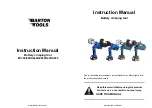
!!!
IMPORTANT
INFORMATION
PLEASE
READ
!!!
5.
BASIC
REGARDING
GRINDING
9
Please keep in mind, that grinding basically is a form of soft treatment. For getting
optional results, please pay attention to some elementary rules.
Physically grinding is a interaction between material of the workpiece, the suitable
abrasive, binding of the abrasive, grit size, cooling liquid and finaly the well matched
feeding size as well as halt and grinding cycles without feeding.
For achieving perfect precision it is basicly considered using small feeding sizes (4 µ),
halt cycles of minimum 15 to 30 seconds at a speed of 10 to 20 rpm, cooling liquid
directed to the circular knife.
It is absolutely recommended to focus your attention to the grinding cycles with no
feeding. This timespan should last a long until you hear no more noise from the grinding
wheel. That grants that the complete feeding size has been worked off.
Surely grinding also means scrub treatment but this is with it's parameters quite sobering
for an amateur in grinding. Scrubbing means very coarse grit, open bonding of the
grinding wheel, feeding of max. 12 µ, halt periods of min. 10 30 seconds, at knife
rotation of 15 to 25 rpm and a lot of cooling liquid.
As mentioned above, these parameters are only a rough guideline which grants that
chooses parameters can be processed by the machine. Finally, factors as grinding
medium and material has to be considered and specially selected for each application.
Material: HSS, highgrade steel hardened, steel hardened etc. can successfully
sharpened with a corundum or CBN grinding wheel.
By use of resinoid bond abrasive material, the cooling liquid should have min. 10% oil
content, as this abrasive bond produces a considerable rubbing on the workpiece causing
more heat.
Material: Carbide steel glass, ceramics can be sharpened successfully by a diamond
wheel. As written before, an adequate oil content has to be considered.





































